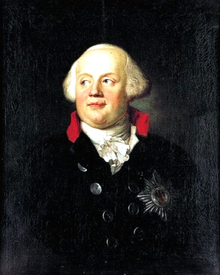Cello Sonata No. 1 (Beethoven)

The Cello Sonata No. 1 in F major op.5,1 is a sonata for cello and piano by Ludwig van Beethoven with two movements.
Emergence
This cello sonata, like its sister work, was written in 1796 after Beethoven met the cellist Jean-Louis Duport at the Prussian court of King Friedrich Wilhelm II in Berlin . Beethoven began composing in the spring of 1796 and probably finished it in Vienna in the same year.
To the music
The composition falls in Beethoven's first creative period.
The designation "Deux Grand Sonates pour Le Clavecin ou Piano-Forte avec un Violoncelle obligé" refers to the role of the cello, which, in contrast to the past, has equal rights. Despite the same conception, possibly borrowed from Mozart's “Sonata for piano and violin in C major KV 303”, Beethoven's two Op. 5 sonatas show clear differences.
1st movement: Adagio sostenuto - Allegro
The first movement of the F major sonata begins with a slow introduction and, after a dominant , which underlines the introductory character of the Adagio with its length of 11 bars, changes into a large allegro . The themes sound, possibly inspired by Mozart, both in the cello and in the piano, with both instruments alternating in their roles as the main voice. Cadenza-like echoes and the way in which the main theme is dealt with give the coda the character of a concert .
2nd movement: Allegro vivace
The finale is in the style of a Mozart rondo. The note repetitions and grinders contained from bar 85 prompted the musicologist Alexander A. Ringer to refer to the movement as “alla turca”.
In the climax of the movement, the rhythm and the pizzicato accompaniment reveal echoes of Beethoven's variation work, inspired by an aria from Wolfgang Amadeus Mozart's opera Die Zauberflöte , In Men Who Feel Love, WoO 46 .
effect
Both cello sonatas dedicated to King Friedrich Wilhelm II of Prussia were printed in February 1797 and published by Artaria- Verlag. In his letter of September 16, 1798, Jean-Louis Duport thanks Beethoven for the copy of Op. 5 and expressed the hope of being able to play the two cello sonatas with the composer.
literature
- Booklet for the double CD Beethoven - Complete Cello Sonatas 1–5. Philips (Universal), 2004.
- Harenberg cultural guide chamber music. 3rd, completely revised edition. Meyers Lexikonverlag, Mannheim 2008, ISBN 978-3-411-07093-0 .
- Jürgen Heidrich: violoncello sonatas. In: Sven Hiemke (Ed.): Beethoven-Handbuch. Bärenreiter-Verlag Karl Vötterleu. a., Kassel u. a. 2009, ISBN 978-3-7618-2020-9 , pp. 476-482.
- Lewis Lockwood : Beethoven. His music - his life. Metzler et al. a., Weimar u. a. 2009, ISBN 978-3-476-02231-8 , pp. 74 ff.
- Alexander L. Ringer: 2 cello sonatas in F major and G minor op. 5. In: Albrecht Riethmüller , Carl Dahlhaus , Alexander L. Ringer (eds.): Beethoven: Interpretations of his works. Volume 1. Laaber-Verlag, Laaber 1994, ISBN 3-89007-305-0 , pp. 41-48.
Web links
- Cello Sonata No. 1 in F major, Op. 5.1 : sheet music and audio files in the International Music Score Library Project
Individual evidence
- ↑ Alexander L. Ringer: 2 cello sonatas in F major and G minor op. 5. In: Albrecht Riethmüller, Carl Dahlhaus, Alexander L. Ringer (ed.): Beethoven: Interpretations of his works. Volume 1. Laaber-Verlag, Laaber 1994, pp. 41-48.
